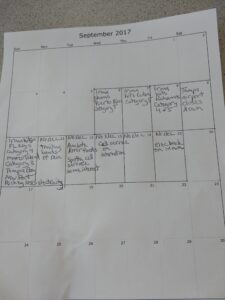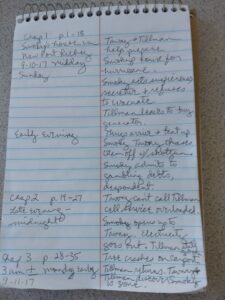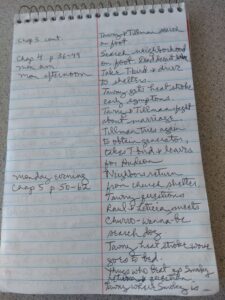By Debbie Burke
Jim Bell’s excellent post from Sunday about plotters vs. pantsers serves as an introduction to today’s subject: Is outlining useful for a pantser? Can it be done?
The answer is yes…if you do it in reverse order.
Create the first draft.
Then go back and outline what you’ve written.
In construction, there’s a term called “As Builts.” An architect may start out with an initial blueprint (outline) but the blueprint changes due to circumstances that arise during construction. The finished building is never the same as the original blueprint. Here’s an explanation from Precision Property Management’s site:
“An As-Built drawing should show the building exactly as it currently is, as opposed to a design drawing which shows the intended or proposed layout of the building. This is a critical distinction, because a constructed building almost never corresponds exactly to the original design drawings.”
Like a building, a finished story almost never corresponds to the initial idea. That’s why I don’t outline before writing that initial draft of discovery.
However, once the first draft is finished, I create an outline in the form of as-builts. That’s where the pantser’s errors and oversights show up. And, believe me, there will be plenty.
Oops, I forgot to install reinforcing bars before I poured the slab. Without rebar, the foundation cracks and sags. Gotta jackhammer up the concrete and start over.
Darn, I forgot to include a door that connects the kitchen and the dining room. Better get out the reciprocating saw and cut an opening in that solid wall.
Wow, the shingles on the roof look beautiful…except some of the trusses underneath are missing. The first snowfall causes the whole thing to collapse. Drat.
You get the idea.
Dennis Foley, novelist/screenwriter/educator extraordinaire, introduced me to the concept of “as built” outlines in fiction. He recommends writing in three steps:
- Think it up;
- Write it up;
- Fix it up.
Pantsers feel strangled if we try to adhere to a formal outline during the initial draft. We’d much rather give free rein to our imaginations during Steps 1 and 2.
But, eventually, all that unfettered creativity needs to be organized. Step 3, the “fix it up” stage, is the time to create an “as built” outline.
Outlining in reverse points out structural problems with the plot: events that are out of order, a character who shows up simultaneously in two different places, missing time periods that must be accounted for, lapses in logic, etc. Once those glitches are repaired, the story becomes a coherent sequence of rising complications that ultimately delivers a satisfying climax.
My WIP, Lost in Irma, takes place in Florida during Hurricane Irma in September, 2017, a catastrophe that left 17 million people without electricity. The story covers a two-week period during and after the storm and had to adhere to actual events in the order that they occurred.
The main characters, Tawny Lindholm and Tillman Rosenbaum, are visiting Tillman’s high school coach, Smoky Lido, in New Port Richey when Irma hits. During the height of the storm, Smoky disappears. Tawny and Tillman spend the rest of the book trying to find him. Is he dead or alive? Did he flee because of gambling debts? Was he abducted by thugs he owed money to? Or did he vanish into the storm to commit suicide?
Hurricane-related emergencies overwhelmed law enforcement, leaving Tawny and Tillman on their own to look for Smoky. Power blackouts, gasoline shortages, and unreliable cell service were integral to the plot. They couldn’t make phone calls or search the internet. If they drove, they risked getting stuck in floodwaters or running out of gas.
 To pin down significant events on the dates they actually happened, I printed out a blank calendar from September 2017. I filled in the squares with factual information like: what time did Irma hit New Port Richey (late Saturday night, early Sunday morning); what time did the power go out there (around midnight); when did the Anclote River flood (Tuesday)?
To pin down significant events on the dates they actually happened, I printed out a blank calendar from September 2017. I filled in the squares with factual information like: what time did Irma hit New Port Richey (late Saturday night, early Sunday morning); what time did the power go out there (around midnight); when did the Anclote River flood (Tuesday)?
Here’s a link to a handy site that includes sunrise and sunset times for each day, which I also found helpful.
Electricity came back on in fits and starts—one street regained power almost immediately while the next block over stayed dark for days longer. That gave me fictional latitude to turn the power off as long as necessary for plot development.
While researching public shelters, I wondered if there was a roster or record kept of people staying there. Astonishingly, no.
I also learned Red Cross maintains an online “Safe and Well” website where victims of disasters can voluntarily register their names, phone numbers, and leave messages for loved ones. But there is no requirement to register.
I inserted that bit of info into the story, adding that the system can’t be accessed if internet and/or cell service aren’t working or your phone is dead with no way to charge it. That added more complications for Tawny and Tillman, who had to physically go through each shelter, looking for Smoky.
What goes into the as-built outline?
Timelines: The chronology of events is important to nail down correctly which is why I use the calendar technique above.
 Scene by scene outline – This traces major characters and plot developments. What day is it? What time is it? Where are they? What action happens?
Scene by scene outline – This traces major characters and plot developments. What day is it? What time is it? Where are they? What action happens?
As you can see from the above illustrations, my outlines are low tech. You may prefer to use Scrivener, Excel, or other spreadsheet programs.
Onstage Characters and Offstage Characters:
Typically, the protagonist appears in most scenes, onstage, and the story is often told from his/her point of view. But if characters are not in a scene—in other words, offstage—they also need to be accounted for, especially in crime fiction.
In mysteries, the murderer’s identity may be withheld from the reader until the very end. But the author still needs to know what that character is up to while s/he is lurking in the shadows. S/he may be trying to elude discovery, throw down false clues, or menace the protagonist. I discussed this topic in a 2017 post.
As a pantser, I often get tripped up because I lose track of a character who’s not onstage at that moment. That’s where the as-built outline catches goofs in the sequence of events.
For instance, the hero can’t find the murder weapon in chapter 4 if the killer doesn’t discard it until chapter 6. Even if you don’t show the killer onstage while he’s tossing the gun off a bridge, you still need to know when that action took place in relation to what the hero is doing. A time line helps point out inconsistencies in the sequential order of events.
Altered Timelines: What if you use flashbacks or jump around in time? Pulp Fiction utilized that technique to memorable dramatic effect. I don’t know how Quentin Tarantino wrote the screenplay but I’m guessing the final version of the film was far different from his initial blueprint.
If you decide to mess around with time conventions, it helps to first write the outline in chronological order. Once that’s done, you can rearrange blocks of time and scenes in any order to best serve your plot line.
Writing About History: If you write historical novels, real events must be accurate. Set up a calendar or time line to cover the duration of the story. This may extend over years or even centuries. Plug in the dates of pivotal events.
For a World War II saga, that might translate to a time line like:
1939 – Nazis invade Poland
1940 – Dunkirk evacuation
1941 – Japanese attack on Pearl Harbor
1942 – Battle of Midway, etc.
Other genres: Even if you write sci-fi or fantasy where the story world is entirely made up, that world must still conform to its own time system that is consistent and logical within its parameters. Suppose in your sci-fi, time travels backwards rather than forward. Events happen in reverse order of what we’re used to. The story might start with the death of a character, then goes backwards year by year, to their birth. Within that logic system, you would see the effect before the cause, the consequence before the action that triggers it.
Time travel stories especially require a clear time line. When you zigzag back and forth through history, it’s easy to get confused. If the author is lost, the reader will also be lost and likely give up on your book.
Jordan Dane just published a gripping time-travel thriller, The Curse She Wore. Maybe she’ll chime in on her techniques to handle multiple time lines.
As-built outlining may seem bass-akward but, for this pantser, it works.
~~~
TKZers: What are your favorite techniques to organize a plot?
~~~
Debbie Burke first used reverse-outlining in her award-winning thriller, Instrument of the Devil. On sale for only $.99 at this link.




Excellent post, Debbie. I’ve been using reverse outlines since about my third novel. Some use a pad of paper and a pen. I keep a Notepad document open on the side named Title of Novel notes.txt.
At the top I list character names and major place names as they appear. Below that I list 1, 2, 3, etc. down the left side.
As I finish a chapter or major scene (often the same thing for me) I take a moment to jot down major characters and a sentence or two about what happened in the scene. If I describe a character or setting in that scene for the first time, I add DESC after the character or place name so I can find the description easily later as I’m writing.
My reverse outline saves me from having to scroll endlessly (or search) through the actual WIP to find some obscure piece of info that I need in the current scene or chapter.
As a bonus, if you’re writing a series, you can combine reverse outlines from each individual book into a “series bible” that serves the same purpose but on a larger scale. (grin) Massive time saver.
Harvey, the “series bible” is a brilliant technique. Thanks for that suggestion.
I’m going to incorporate your “character DESC” subheading into my as-builts. I’ve wasted many hours searching for obscure but important details. Or realized I forgot to describe a character altogether–just cuz I see him clearly in my mind doesn’t mean that picture ever made it to the page.
Thanks for adding useful tools to our belts.
I used to use a large foamcore board and post it notes. I used the standard 3×3 sized ones for my 2 POV characters, and summarized the plot points. I tracked what story date it was, day of the week if needed, which secondary characters were in the scene, and the setting. When I was good, I did it after each scene or chapter. I’ve gotten lazy. Now, when I’m ready for my first draft read-through I make the same kinds of notes on a legal tablet and use sticky notes when I find things I want to go back and check, like consistency in usage, or continuity issues.
I should have created a series Bible long ago, but now, it’s too daunting. I wish I had a super fan who’d volunteer to do it for me!
I’ve occasionally used a dry-erase board but it’s always smearing when adding info to the middle.
Index cards, one for each character and each scene, spread out on the living room floor works…until the dog prances across the jigsaw puzzle.
Hope your super fan steps forward, Terry!
Here’s another subject this brings up for future articles. The book bible where you keep daily notes as you go of minor and major information. The neighbor’s name and description. A quick sketch of the hero’s house. The kind of gun the heroine keeps in her bedstand. Etc. The book bible will later be worth its weight in gold if this is a first in series.
For those of us who outline first, we also figure out the plot logic, etc., as we outline so it’s a good thought process for all writers.
And even more good news about the outline is that you’ll need it as a starter resource if you want to sell your book to a traditional publisher who often demands an outline.
Great suggestions, Marilynn. Thanks for adding to the discussion.
Thanks for the suggestions! I’m starting the third in my series, which will actually be the most complex, because it is a prequel, and I have to true to the events already written.
Julie, a prequel is a great time to start the series bible b/c you’re establishing the characters’ baseline and history, the foundation on which the whole series rests. Best of luck.
Hurricane Irma was lots of fun. We lost power for a week. My hubby was in the hospital having surgery (not hurricane-related) and the temperature in the house was insanely hot. The dogs and I would retreat to the car for a/c and charging my phone.
The power company (brought in from NC) used our yard as a staging area. We were the last to get power back, but I kept them supplied with donuts anyway (Krispy Kreme up the street had power).
One thing I learned growing up in hurricane country is every hurricane has a miracle. Ours was we lost a palm tree that by all rights should have crashed on me while I was sleeping. Instead it fell neatly alongside the house. When the haul-away crew came to move it, they asked who moved it aside for us as there’s no way it should have fallen where it did. I said “My guardian angel.”
Cynthia, have you been peeking at my notes? 🙂 Although I wasn’t in Florida during Irma, my husband was and so were many friends. I’ve picked their brains.
Other people report similar miracles to yours. Glad you made it through in good shape. Irma was a doozy.
Debbie, I’ve told pure pantsers this for years. You’re NOT really writing a first draft. You’re writing a big, messy outline. This is your discovery draft. Which is fine. It can work. It’s just that, as I wrote Sunday, each path a pantser takes is a commitment of thousands, maybe tens of thousands, of words, and two, three, or four months writing time. The outliner is discovering things fast, keeping, discarding, not needing to commit every moment, and all in a matter of a week or two.
Nice food for thought post.
Unless you’re someone like Jeffery Deaver who says he spends 8 months outlining his books, then two months writing it.
Thank you, Jim.
I think the “O” word strikes fear in the hearts of many pantsers b/c they flashback to 8th grade and that unforgiving English teacher who made them diagram their reports with Roman numerals, upper-case and lower-case letters, etc.
Someday, I hope to be as efficient as you!
OMG, does that bring back memories of the outlining English teachers and their diabolical essay outlines. I remember mine saying “you can’t have an A without a B, and you can’t have a I without a II”.
Looking back, yes, it’s an amazing way to organise your work. A is a thesis statement. i is a point, ii is a point, iii is a point. B is a thesis statement… blah blah blah.
But at the time? That was something to dread. Makes me wonder if that’s the reason I was so good at writing (and teaching how to write) essays.
Mollie, we hated it but it worked. I can still see Mrs. Shore with her snowy white hair and stacked-heel “old-lady shoes”, writing outlines on the chalkboard. Of course, I’m probably older now than she was back then!
I keep saying it. Over and over. It’s probably getting aggravating to y’all! The timeliness of these posts just blows my mind…
I love this post, Debbie. I’ve been wondering about going back and outlining my current WIP. I have the first draft, am editing it, and need to do some layering of backstory tidbits, etc. The thing that’s been driving me crazy is that I’m not sure of the premise of the story. I want the entire novel to span only twenty-four hours, give or take. I’m convinced it’ll work. But I don’t want it to drag, or be just a string of frightening circumstances in my MC’s day. There has to be a reason she is scared out of her wits. The reader needs to know, at some point, what happened to her before the story starts. I think her backstory will be the carpenter’s glue that binds the novel tightly together.
So, based on this post, I think I’ll make a “calendar” of hours in her day, a clock, if you will. List each hour, what happens to her, and what it has to do with her fear. (I know that without knowing more about the story, it’s hard for you to understand where I’m going with it…) She has lived her whole life in fear, waiting for the other shoe to drop-in fact she says that at the end. And she doesn’t want to pass that on to her four kids.
Sorry to go on and on, but I’m just so darned excited about this “outlining in reverse” concept. I thought about doing it, but thought I’d break some cardinal rule of the craft or something. Now I can dig in and do it. I’ve always been a little backwards anyway. 🙂
So glad this helped you, Deb!
Synchronicity is what Jung called the phenomenon you describe. Wikipedia definition: “events are ‘meaningful coincidences’ if they occur with no causal relationship yet seem to be meaningfully related.”
Writing has no cardinal rules. Try something. If it doesn’t work, try something else. Eventually you’ll collect a bag of tricks that fits your style and way of thinking.
P.S. Remember the TV show “24”? The story happened over a one-day period, in one-hour-long segments. Worked great for that so why not for your book?
My thought exactly!
Wish I had this post when I wrote by the seat of my pants, Debbie. Now, I can’t even imagine the horror of staring at a blank page without at least having my milestones in place. But I respect your process. No one way works for everyone. Writers are like fingerprints…no two are alike. 😉 Love your calendar idea! I may have to adopt that. Thank you.
Fingerprints are a perfect analogy for each writer’s unique process, Sue.
And the process constantly evolves with tweaks and tricks we pick up from conferences, critique groups, craft books, and writing blogs.
I’m not ashamed to admit it, “I’m a plotter.”
I maintain a series bible for two series. I keep track of written details for the story and the characters in it, I keep outlines of future books in the series. I keep track of little details I put in a story with the deliberate intention of coming back to them in a future book. I keep …
And I’m a research junkie.
It’s surprising I actually write anything.
No shame at all in being a plotter, Michelle. Outlines and notes are important to keep research organized. But oh those rabbit holes go deep…
I love this. I’ve finished my 3rd draft, and this is really what I should do next. Think I’ll buy some butcher paper. Thanks.
Nancy, back in the days before computers, many writers used butcher paper, esp. for timelines of big historical sagas that covered many decades and multiple generations.
A well-known bestselling novelist (whose name escapes me at the moment) wrote her outlines in magic marker all around her office walls. After she’d finish a book, she’d have the room repainted.
the biggest oops that every showed up in a book for me was a character who was pregnant for 2 years. Wow. What a drag that would be! Great article!
What a hoot, Karen! That poor woman had it worse than an elephant!
Your 10-foot-long outline will make a terrific show-and-tell for a presentation. Hope I’m in the audience for that.
For my first book, I have a ten-foot-long chart (of taped together typing paper) with categories including characters in each chapter, conflict, main event, subplot addressed, personal conflict, interpersonal conflict, external conflict, repeated motifs mentioned, etc. etc. It’s a monster of a spread sheet. i’ve always said that someday when I’m asked to do a keynote speech, I’ll take it out and show it off. 🙂
I do the same. I may start writing with a few bullet points, like beginning, end and a couple of things that must happen, but I do an organizing outline after the first draft. I do mine in Excel so I can move scenes around or color code or make notes. This is also the point where I visit writing books such as Writing the Breakout Novel Workbook or Story Genius to deepen the work.
Kerry, great suggestions to consult writing craft guides *after* you’ve written the first draft. Once there are actual scenes written down, it’s much easier find trouble spots where you can apply specific lessons and techniques suggested by the guide books. Otherwise, those lessons seem like vague generalities. Thanks for chiming in.